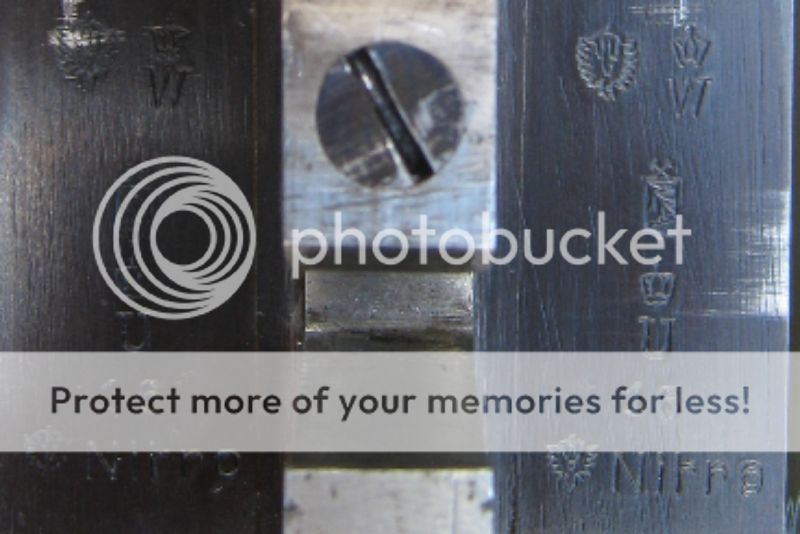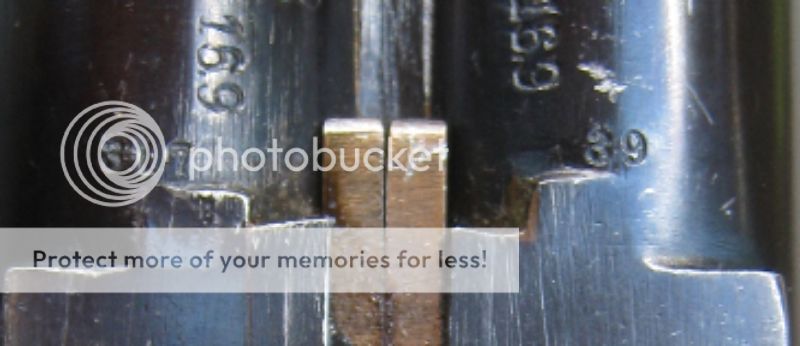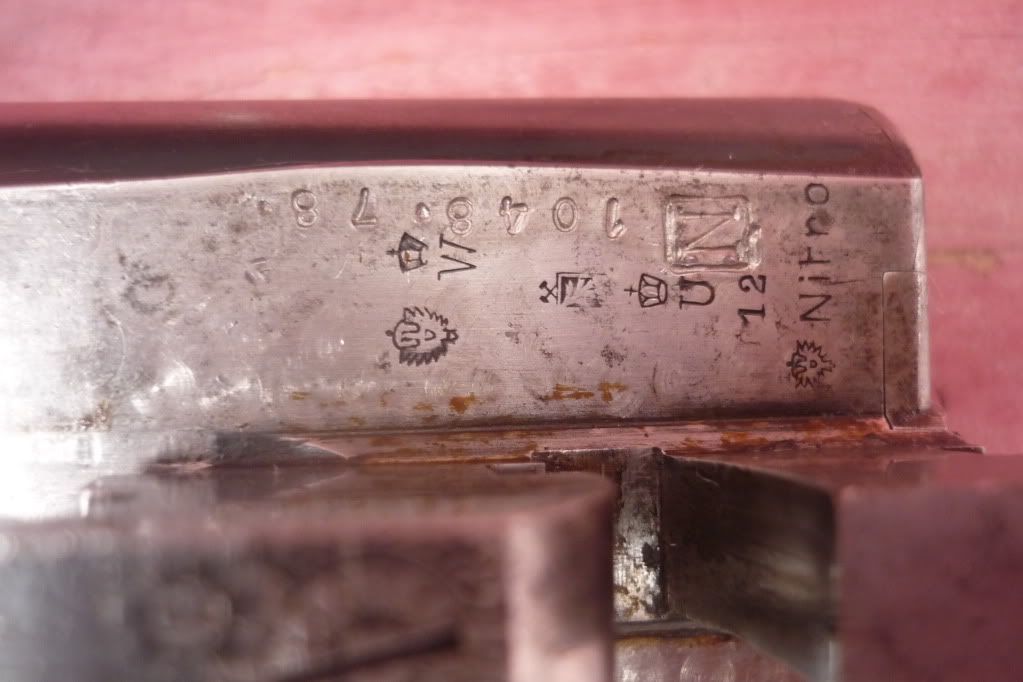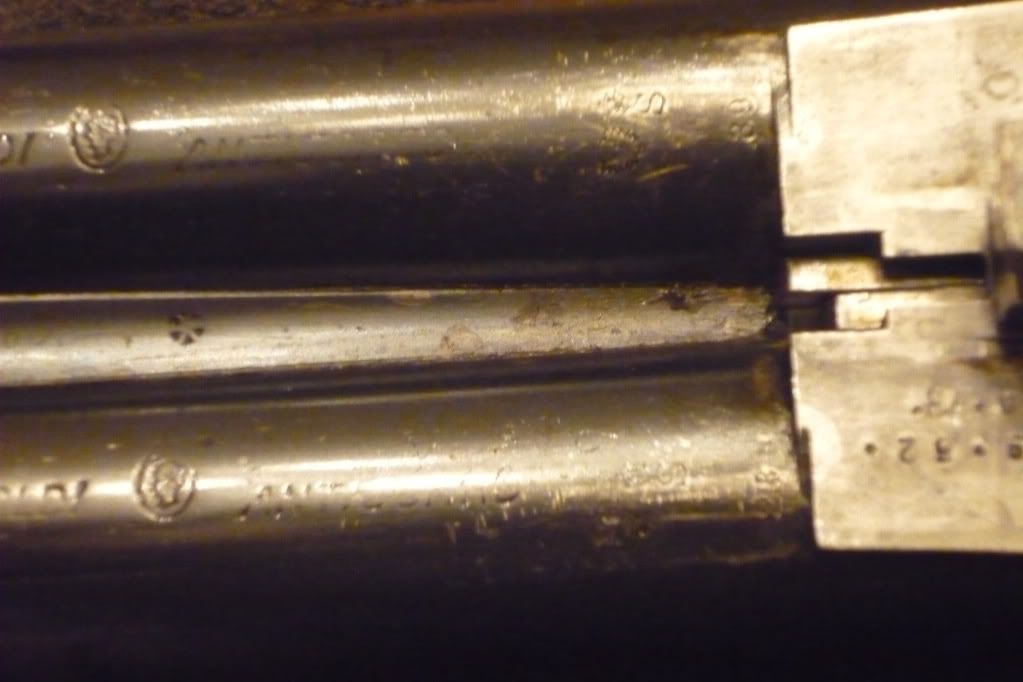|
S |
M |
T |
W |
T |
F |
S |
|
|
|
|
1
|
2
|
3
|
4
|
|
5
|
6
|
7
|
8
|
9
|
10
|
11
|
|
12
|
13
|
14
|
15
|
16
|
17
|
18
|
|
19
|
20
|
21
|
22
|
23
|
24
|
25
|
|
26
|
27
|
28
|
29
|
30
|
31
|
|
|
|
Forums10
Topics39,492
Posts562,049
Members14,585
| |
Most Online9,918
Jul 28th, 2025
|
|
|
|
Joined: Apr 2005
Posts: 1,784 Likes: 15
Sidelock
|

Sidelock
Joined: Apr 2005
Posts: 1,784 Likes: 15 |
Raimey, I don't mind being close  A very nice 16x16. With kind regards, Jani
|
|
|
|
|
Joined: Mar 2011
Posts: 23 Likes: 4
Boxlock
|
OP

Boxlock
Joined: Mar 2011
Posts: 23 Likes: 4 |
Thanks guys for sharing your knowledge.
If I understand correctly Weipert is located in Austria in the border area with Germany so this gun was built in that general area using a German frame and a Belgian tube set and proofed in Weipert. Which is the Weipert Mark and what suggests Neumann Freres barrels?
What suggests to you it's manufacture to be during the WW1 era?
I see know indication of chamber length or anything that indicates at what load the barrels proofed at. Do marks indicate this information?
Kind Regards, Jim
|
|
|
|
|
Joined: Aug 2007
Posts: 12,077 Likes: 378
Sidelock
|

Sidelock
Joined: Aug 2007
Posts: 12,077 Likes: 378 |
 The Weipert stamp is the leaning/falling fir tree in an escutcheon/shield surmounted by crossed iron clubs or flails just below the Crown over W. Typically this represents the 2nd pass for a tube thru the Weipert proof facility say till 1927-1928. So let me revise my guess on the date. I'm not sure of the exact date of occupation(some time in 1938??), but Germany was in control of the proof facilities in the Sudeten Protectorate by 1939. Prague's proofmarks were recognized but I don't believe Weipert's were. Only the Escutcheon/Shield with the Leaning/Falling Fir Tree surmounted by crossed iron clubs or flails was allowed to denote which German controlled proof facility thru which the sporting weapon passed. What is missing is the 2nd Imperial Eagle along with an encircled 16 noting 65mm chambers. On face value it would seem that the marks are mixed regarding the proof facilities. But closer inspection would say that some mechanic in Weipert married a Belgian Krupp steel serialized tubeset to a frame and sent it thru the Weipert proof facility sometime between the original occupation of the facility by the Germans up till the mandatory June 1st, 1940 new proof law.  I'm curious what those numbers are just ahead of the flats. Why there isn't a final pass datastring or datecode as we know it, I cannot say. Kind Regards, Raimey rse
|
|
|
|
|
Joined: Aug 2007
Posts: 12,077 Likes: 378
Sidelock
|

Sidelock
Joined: Aug 2007
Posts: 12,077 Likes: 378 |
You know, after starring at it for a time, the pairing of 317.39 just may be the final pass datastring making the example from early 1939.
Kind Regards,
Raimey
rse
|
|
|
|
|
Joined: Jan 2002
Posts: 11,571 Likes: 165
Sidelock
|

Sidelock
Joined: Jan 2002
Posts: 11,571 Likes: 165 |
Raimey, per Baron Engelhardt, the gauge in a circle didn't indicate 65MM chambers. It simply indicated what size shells you use in the gun. Or, if you will, the size of the chamber. I had a 30's era Sauer 20ga: 20 in a circle to indicate the shells I needed to buy, 19 not in a circle indicating the true bore size. It was a 2 3/4" gun, and that was stamped on the extractor luggers. (A&F import, expect it would have been marked 70MM if made for the European market.) I think the lack of 2 3/4" or 70MM is what tells us it has 65MM chambers.
Last edited by L. Brown; 09/03/14 07:19 AM.
|
|
|
|
|
Joined: Dec 2001
Posts: 12,743
Sidelock
|

Sidelock
Joined: Dec 2001
Posts: 12,743 |
I have a Ca 1902 12ga sidelock VL&D/J P Sauer & Son "Knockabout" with 2 3/4" chambers. With the VL&D connection & the "Son" spelling it was definitely built for export to the US. It has the 12 in a circle marking & the face of the extractors are stamped 70.
I believe the key here is if it has only the chamber mark of gauge in a circle with no additional marks it is reasonably safe to assume it was chambered for the "Standard" shell. For continental guns this would have been 65mm (approx 2 9/16"). Also many "So Called" British nominal 2½" guns seem to have chambers running from 65mm-67mm (2 9/16"-2 5/8").
Miller/TN
I Didn't Say Everything I Said, Yogi Berra
|
|
|
|
|
Joined: Aug 2007
Posts: 12,077 Likes: 378
Sidelock
|

Sidelock
Joined: Aug 2007
Posts: 12,077 Likes: 378 |
Mr. Brown you may be most correct & I should qualified it better. Encircled 16 - black powder, 65mm chambers when devoid of 70mm stamp & Nitro. Anyway, Canvasback has a Lovely Lovena from the same time period & when I 1st made an assessment of it, clearly I missed the numbers just ahead of the flats. So it too experienced proof in 1939:   I believe the preponderance of evidence is tilting in favour of the numbers just ahead of the flats are the final pass datastring with the proofhouse number on the underside of the right & the year on the left. Very odd that the Weipert facility abandoned all of their post 1928 marks less the fir tree. http://www.doublegunshop.com/forums/ubbthreads.php?ubb=showflat&Number=205685&page=1So Canvasback, can you provide the numbers on each tube just ahead of the flats? Kind Regards, Raimey rse
|
|
|
|
|
Joined: Aug 2007
Posts: 12,077 Likes: 378
Sidelock
|

Sidelock
Joined: Aug 2007
Posts: 12,077 Likes: 378 |
Canvasback:
Skip that request as you've already supplied 238 & 39. If these are the final datastrings these passed only a few numbers apart. Tough to say seeing we are dealing with some bastard proofs being a mix of proofhouses/laws. Clearly the encircled bore/chamber data was not in the mix. I guess the Weipert ledger would answer all questions.
Kind Regards,
Raimey
rse
|
|
|
|
|
Joined: Aug 2007
Posts: 12,077 Likes: 378
Sidelock
|

Sidelock
Joined: Aug 2007
Posts: 12,077 Likes: 378 |
Jim:
To answer your questions, first I'd ask is there a 70mm on either of the ejector faces? the NF in a rectangle just may point to Neumann Frères. At some point, the stamp of the Escutcheon/Shield with the Leaning/Falling Fir Tree surmounted by crossed iron clubs or flails noted the 2nd pass(1st pass was black powder) being semi-smokeless yielding a pressure given as 12,800 psi. That's the Weipert values. The German method should have been a powder charge of 2 times the service load behind a shot charge of 1 1/3 times the service load. Seeing that the German occupation saw what is given as a total replacement of the proof law, and that the 1939 rules replaced black powder with semi-smokeless for almost all instances, I wonder if the Weipert facility in 1939 was looking in the past or toward the future?
Kind Regards,
Raimey
rse
|
|
|
|
|
Joined: Aug 2007
Posts: 12,077 Likes: 378
Sidelock
|

Sidelock
Joined: Aug 2007
Posts: 12,077 Likes: 378 |
Jani, looks like we are going to have to raise your mark as it appears you were spot on; who said you hadn't been thru Josef Ritter's shop???
Kind Regards,
Raimey
rse
|
|
|
|
|